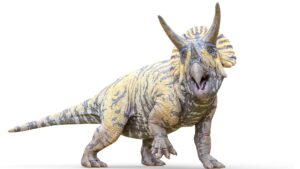
By applying new technology to the study of ancient history, researchers hope to improve their understanding of dinosaurs through the use of a new artificial intelligence system. The work, published in Frontiers in Earth Science, scans and evaluates dinosaur fossils using high-resolution Computed Tomography (CT) imaging paired with deep learning models.
The discovery is a first step toward developing a new tool that has the potential to fundamentally alter how paleontologists study ancient remains.
“While computed tomography and other imaging techniques have revealed previously unknown features in fossils, the high-resolution images need weeks, if not months, of post-processing, typically segmenting fossils from rock matrices.
AI can not only accelerate data processing in fossil studies but also establish benchmarks for more objective and reproducible research,” said lead author Congyu Yu, a Ph.D. student at the American Museum of Natural History’s Richard Gilder Graduate School.
To gain a complete picture of these creatures, paleontologists concentrate on the internal anatomy of ancient vertebrates, such as cranial capacity, inner ears, and vascular spaces. To accomplish this, researchers employ a method known as thin sectioning.
By excavating a small section (as thin as several micrometers) from a fossil, analyzing it under a microscope, and documenting the structures they discover, they can piece together a dinosaur’s morphology. This process, however, is damaging to the remains and can be somewhat time-consuming.
Computed tomography (CT) scans enable scientists to peer inside a sample while preserving the fossil. The technique studies a fossil part in detail, taking thousands of photos. The images are then reconstructed and a three-dimensional graphic is created, resulting in an internal snapshot of the sample.
Scientists can then inspect and annotate distinguishable features within the graphic in order to gain additional information about a specimen.
Imaging has provided scientists with a means of uncovering previously unknown interior structures and creating 3D models of dinosaurs. Researchers have used studies to determine body weights, assess skulls, and even better comprehend dental morphology and tooth replacement trends.
However, this approach requires scientists to manually segment, inspect, and label photos, which is time-consuming and subjective, and prone to error. Additionally, scans have difficulty distinguishing between the rock that may cover a fossil and the bones themselves, making it difficult to establish where the rock ends and the fossil begins.
AI has demonstrated its ability to segment images quickly in the medical field, from diagnosing brain abnormalities to skin cancer. The researchers recognized an opportunity to apply comparable deep learning models to CT pictures of fossils.
They validated this novel method using deep neural networks and over 10,000 annotated CT scans of three well-preserved Protoceratop dinosaur fetal skulls. These fossils, discovered in the 1990s in Mongolia’s Gobi Desert, are from an early horned dinosaur that is a smaller relative of the more well-known Triceratops.
The scientists trained the system to detect rock from fossils using a conventional U-net deep neural network. For training feature recognition, categorization of CT image segments, and 3D rendering, a modified DeepLab v3+ network was employed.
The models were trained on 7,986 manually annotated CT slices of bone structures using the cuDNN-accelerated TensorFlow deep learning framework on dual NVIDIA GeForce RTX 2080 Ti GPUs.
They discovered that while the segmentation model achieved a high accuracy of roughly 97 percent when tested against a dataset of 3,329, the 3D feature representations were not as precise or exact as humans.
While the feature model did not function as correctly as the scientists predicted, the segmentation models performed flawlessly and quickly, segmenting each slice in seconds.
Segmenting the same item manually takes minutes, if not hours, in some circumstances. This could help paleontologists spend less time separating fossils from rock.
The researchers indicate that larger data sets with other dinosaur species and soil types could aid in the development of a high-performing algorithm in the future.
“We are sure that a segmentation model for fossils from the Gobi Desert is not far away,” Yu stated in a news statement. “However, a more generalized model requires not only additional training data but also algorithmic breakthroughs.”
“I believe that deep learning will someday be able to analyze imagery better than humans, and there have already been several instances of deep learning outperforming humans in tasks such as Go playing and protein 3D structure prediction.”